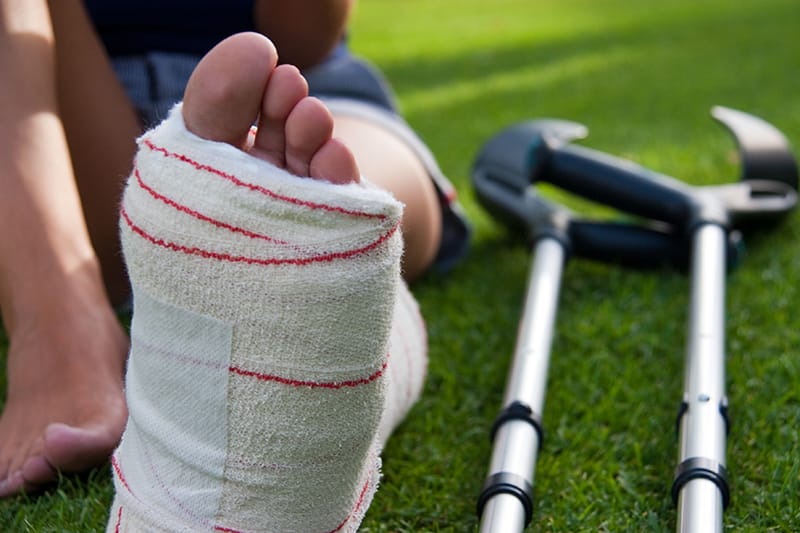In the year-round culture of youth sports, seasons never end. They overlap with other sports or move right back into training, club teams and AAU.
But there’s something different about fall sports. The long layoff of summer provides more time for leisure and more time for athletes to fall out of mid-season form.
As a parent, what common fall sports injuries should I worry about?
When you think of fall sports, you think of football. That’s also the one physicians think about most due to the frequency and types of injuries. Kids can get injured in any sport, though. Strains and sprains are the most common, but young athletes typically bounce back from those injuries quickly. There are other injuries that are harder to predict.
Concussions
Concussions are most common in football and, to a lesser extent, soccer. Collisions happen, making them difficult to prevent. Spotting the signs of a concussion and treating it early are important.
“Physicians, trainers and coaches aren’t around them all the time, so parents are often the ones who first notice their child is not acting their normal self, is a little foggy or is just not as sharp,” says Matthew Nicholson, DO, family medicine physician at The Iowa Clinic – Altoona. “Recognizing that is a big thing.”
Early recognition gets your child into treatment faster and keeps them from returning to play too soon, where they’re more likely to experience a repeat concussion. Recovery requires both physical and cognitive rest until symptoms subside. That means no screens of any kind, says Dr. Nicholson.
“No TV, no computer and no phones. It’s a hard thing to do nowadays. But that’s where, unfortunately, the parent has to be the bad guy and take those things away. The more athletes adhere to that, the faster they’re going to heal up.”
Muscle Cramps
Cramps crop up early in practices and creep into the first couple weeks of games. Summer workouts don’t match the intensity level of competition. And some athletes just start training when the season begins instead of gradually increasing their activity over time.
Cramping is often due to a lack of hydration. Most athletes aren’t drinking enough water or only do so during games, Dr. Nicholson says. Traditional advice says they need to drink eight glass of water a day. He advises athletes to aim high and drink as much as three liters a day, which would be more than 12 cups.
“You need to start hydrating the day before activity to prevent cramping. And there’s no substitute for good old water. With a lot of sports drinks, you have to be careful of the amount of sugar, which can actually worsen the problem. The sugar-free sports drinks are better if you do have an electrolyte imbalance.”
Muscle Tightness
Muscle tightness often goes hand-in-hand with muscle cramps. It’s another problem commonly seen as athletes work themselves into shape in the first few weeks of the season.
Taking the time to properly warm up and stretch is the most important thing an athlete can do. Outside of that, working on flexibility on their own helps prevent muscle tightness. If these treatments — in combination with at-home treatments like rest, ice, heat and anti-inflammatories — don’t help, you should take your child into their provider.
“If it becomes a recurrent thing that happens over and over in practice or in a game, you should bring them in to get looked at and make sure we’re not missing something else,” says Dr. Nicholson. “Tight muscles in the hamstrings, quads and calves also mean the ligaments and knees aren’t quite as flexible. So if the muscles aren’t giving as they should, the next thing you know, kids end up with ACL tears, ankle sprains and that sort of thing.”
Leg and Ankle Injuries
Strong muscles eliminate tightness and stabilize the knees, ankles, hips and other joints. The more your athlete strengthens and stretches their muscles, the less chance they have of sustaining a more serious injury.
Even that can’t prevent everything. In sports like volleyball and cross country, the playing surface or course presents problems like shin splints, knee and ankle injuries, turf toe and plantar fasciitis.
Dr. Nicholson recommends athletes not jump right into the season and instead build up their endurance and strength gradually to prevent some of the overexertion injuries. For injuries sustained on an unforgiving gym floor or uneven grassy field, it gets back to strengthening and stretching.
Is there anything I can do to help my kid avoid sports injuries?
Always. The more reinforcement and encouragement you can give your children at home, the better. Whether it’s training or home stretching programs to prevent injury or physical therapy or rehab from an existing injury, it’s all designed to promote healing, improve outcomes and prevent further injury. And you can help hold them accountable or work through it.
An open line of communication with your athlete is critical. They might try to deal with an injury on their own for weeks and keep you out of the loop. That can increase their risk of further injury and delay recovery. It sounds simple, but just knowing how your child is feeling goes a long way.
Where should I take my child when they have a sports injury?
Sports medicine clinics specialize in orthopedic injuries for athletes, especially if there are broken bones, damaged ligaments or a need for surgery. Often, you don’t know the severity of the injury until you talk to a doctor.
You can schedule an appointment with your primary care provider or visit your nearest Urgent Care clinic if the injury happens over the weekend or is more concerning. If your child experiences anything traumatic, a visit to the emergency room is warranted. But the most common sports injuries can probably wait until the clinic opens up the next day.


